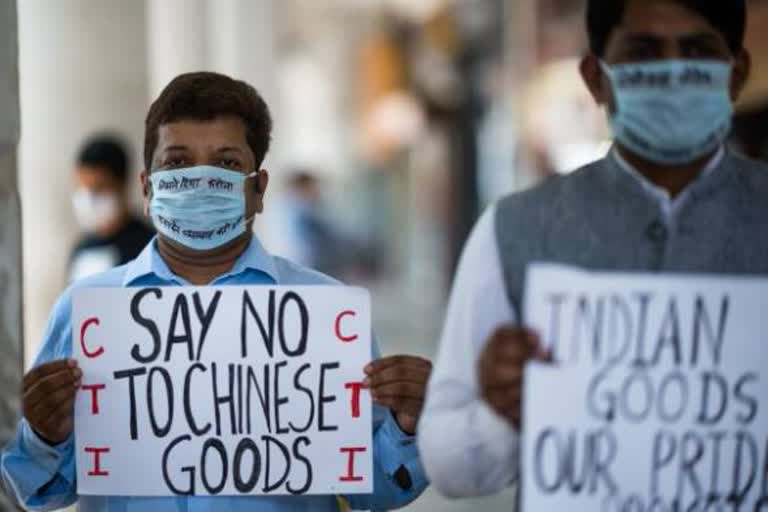New Delhi/Mumbai: India can afford to boycott "Made in China" products only by developing domestic industries and diversifying its sources of import.
Incidentally, the opposition to the flood of cheap 'Made in China' products in the domestic market has been steadily growing over the years.
However, the sentiment got a major push due to the ongoing Himalayan stand-off between the Asian giants.
Accordingly, industry and trade experts contended that a move to fully boycott Chinese products will not just require time but also strategic policy intervention and support to develop domestic industries.
Similarly, duty hikes and implementation of quality control norms would be required to stave-off dumping activity.
Besides, trade analysts cited the need to source imports from other countries, thereby, reducing dependence on Chinese industries.
"Indian consumers may boycott Chinese goods such as toys, leather bags, mobile handsets and other goods in the lower price range," Rupa Naik, Senior Director, MVIRDC World Trade Center Mumbai told IANS.
"However, the real challenge would be to boycott B2B goods such as industrial machineries, fabricated equipments used in industries, chemicals and plastic products that are used in manufacturing. India depends on China in electronics, machinery, pharma, chemicals, fertilizers and auto components is anywhere between 25-70 per cent. It is difficult to manufacture these goods locally at a short notice."
On the other hand, Naik pointed out that India's exports raw material to China is significant.
"We have been exporting minerals, ore, agri commodities and importing value added products from China," Naik said.
"This has significant impact on domestic industries. We must first begin with containing raw material export to China and make it available to domestic industries to help in making them self-reliant."
At present, India's trade deficit with China is declining due to imposition of antidumping duty in sectors like steel.
In FY20, India imported $65.1 billion worth of "Made in China" products, and exported only about $16.6 billion to the East Asian country, thereby, recording a trade deficit of $48.5 billion.
"There is a case for encouraging domestic small scale producers of low value added goods like toys and household appliances vis-a-vis imports not just from China but also other nations," said Sankar Chakraborti, Group CEO of Acuite Ratings and Research.
"Higher trade barriers with China is likely to lead to fresh investments in the manufacturing sector in India by foreign players, given the large size of the domestic market."
Read more:How China made merry on India's rapid power sector expansion?
Furthermore, Chakraborti pointed out that indigenous suppliers in sectors such as chemicals and bulk drugs, capital goods, auto components and consumer durables can benefit if imports are discouraged or additional duties are imposed.
"A concerted effort by the government and the industry to encourage the development of indigenous manufacturing capacities in India as a substation for imports will lead to an increase in private sector capital expenditures," Chakraborti said.
"It will be important to ensure two things to build a large investment pipeline in the private manufacturing sector. One is adequate trade protection to these indigenously developed capacities till they attain cost competitiveness at the global level and also ensuring availability of debt funding from banks for such new projects."
As per an Acuite ratings' report, India can potentially reduce its trade deficit with China by $8.4 billion over FY21-22, via rationalisation of just a quarter of its imports from the East Asian country.
In terms of import barriers, highly placed sources have indicated that certain high volume import products from China may attract steeper tariffs.
These tariffs might have different range and scope such as imposition of countervailing and anti-dumping duty or a basic custom duty hike.
Several products such as printing paper, toys, toners, AC compressors, general use electrical wires and switches are amongst items that have been identified for either a tariff or quality control standard hike, sources said.
In contrast, machinery components, pharma ingredients and other goods that go into the final manufacturing of finished products have been left out for now.
According to Shirish Ghoge, an independent industry expert and a former senior director with Abbott and Sanofi: "India's pharma industry can regain its edge in API manufacturing if proper support and fiscal push is provided."
"It is not a rocket science. We were way ahead in API manufacturing in the past and we can still achieve that mark with proper government support."
In terms of automobile components, Sridhar V, Partner, Grant Thornton India LLP said: "Our imports of auto components from China is about 25 per cent of the total imports by the industry. With respect to EV's the dependence is all the more. An outright boycott can not be a right solution but a conscious and persistent move to encourage local manufacturing with the right type of fiscal and financial support can help India to be self reliant on many aspects thereby bringing down our dependence on China."
"This is a fairly long term approach. In the medium term one should also explore alternate supply sources to keep our economy going. Our private sector has the capabilities to rise to the challenge."
Even the country's nascent drone manufacturers are looking for alternate sources of component supplies.
"The drone industry is actively looking for alternate supply chain options for components like batteries and motors. Also, there is a growing consensus amongst the drone industry to raise R&D funds towards indigenisation of these components," said Smit Shah, Director - Partnerships, Drone Federation of India.
"Multiple industry stakeholders should come together to identify common products and pool resources to achieve this."
(Written by Rohit Vaid and published in arrangement with IANS.)



